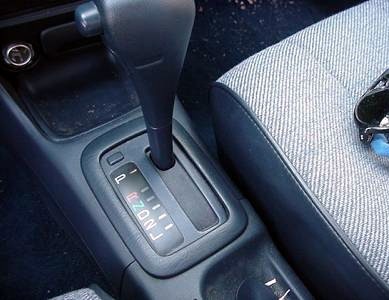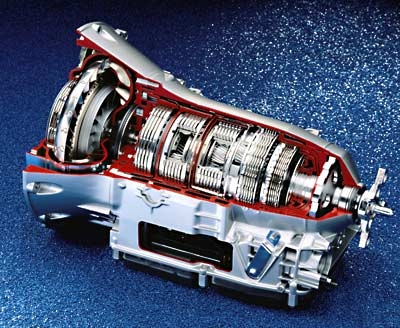By following the procedure described in this article, you may be able to repair an automatic transmission that is slipping. “Slipping” is the term applied to a transmission that doesn’t shift gears at the proper time. The condition is identified by a lag in upshifting as engine speed increases.

It is important to note that the repair is actually the severe service maintenance procedure suggested by vehicle manufacturers to prevent slippage from occurring in the first place. Manufacturers claim that performing this service every 25,000 miles, if you operate your vehicle under severe driving conditions, will prevent failure of an automatic transmission. Severe driving conditions are the following:
- Operating a vehicle primarily in stop-and-go city traffic most of the time.
- Operating a vehicle more than half the time in stop-and-go city traffic when the ambient temperature is 90°F or higher.
- Using a vehicle to tow a trailer.
- Driving a vehicle primarily in a dusty environment.
- Driving a vehicle primarily over hills or mountains.
These severe driving conditions cause fluid in an automatic transmission to overheat and become contaminated. The fluid then loses its ability to protect delicate parts of a transmission, which will sustain damage.
Periodically draining and examining automatic transmission fluid in a vehicle used under one or more severe conditions will allow you to detect the onset of trouble. Professional transmission repair services can fix it for you with ease. If failure has already occurred and a transmission is slipping, replacing the fluid could also resolve the problem.
Whether you are attempting to repair an automatic transmission that is slipping or have decided to implement a maintenance program to ward off trouble, the following describes what to do. Suppose, however, the problem you’re having is not a slipping transmission, but a fluid leak from around the transmission pan. The same instructions can be followed to repair the leak.
- Drive the vehicle at least 10 miles to heat the transmission fluid.
- Park the vehicle on a level surface, shut off the engine, place the transmission shift selector in Park, and engage the parking brake.
- Jack up the front of the vehicle using good quality Floor Jacks.
- Place a support stand under each front control arm and lower the vehicle onto the stands.
- Ram chocks against both sides of each rear tire to prevent the vehicle from rolling back.
- Place a large pan under the transmission pan.
- Remove the bolts by starting at a corner, so that the corner drops lower than the rest of the transmission pan, and allow fluid to flow into the other pan.
- Take out the remaining bolts and remove the transmission pan.
- Before discarding the fluid that remains in the bottom of the transmission pan, inspect it for particles, color, and odor. Slosh the fluid back and forth. The presence of fine black and/or brass residue is normal. However, if larger pieces are visible, pour the fluid containing the particles into a clean jar and take-it to a transmission specialist. The specialist will be able to determine what should be done to prevent damage from progressing to an advanced stage. Fluid should be red. If it looks muddy and/or smells like varnish, filling the transmission with fresh fluid may straighten out a slipping condition. Incidentally, if fluid is white, the transmission oil cooler has a leak that is allowing coolant to mix with transmission fluid. Take the vehicle to an auto repair shop to have the cooler replaced.
- Continue the repair by peeling or scraping off the gasket from the rim of the transmission pan and from the rim of the transmission body. All of this material must be removed or it will prevent the pan from seating securely to the transmission. This will cause a fluid leak.
- Using a nonflammable solvent, which is available from an auto supply store, wash the pan.
- Locate the transmission fluid filter inside the transmission. It is out in the open and easily reached. Remove the screw(s) that hold the filter in place and take the filter out of the transmission. If the filter is made of paper or felt, replace it. If it is made of metal, wash it in nonflammable solvent and put it back into the transmission.
- Place a new gasket on the rim of the transmission pan so that the holes in the gasket align with the holes in the rim of the pan. Make sure the gasket lies straight as you place the pan against the body of the transmission, and insert the bolts.
- When all bolts are in place, tighten a bolt using a wrench. Then, tighten the bolt that lies diagonally across from the one you just tightened. Follow this pattern to tighten all the bolts.
- Remove the automatic transmission fluid dipstick. Wipe it with a clean cloth and place it where it won’t become dirty.
- Insert a clean funnel into the dipstick tube and pour in one quart of the type of automatic transmission fluid recommended by the vehicle manufacturer. This information can be found in your owner’s manual. Use only this fluid, as any other type can cause transmission damage.
- Reinsert the dipstick and pull it out again to check the fluid level. Continue filling the transmission in this manner until the fluid level hits the FULL mark on the dipstick.
- With the dipstick seated in the dipstick tube, start the engine and let it warm up for five minutes. Then, move the transmission shift lever through all gears and back again toward Park, pausing momentarily between each shift. Keep your foot planted firmly on the brake pedal to prevent the vehicle from moving.
- With the shift lever again in Park, turn off the engine and withdraw the fluid dipstick to check the fluid level. If it has dropped below FULL, add enough fluid to bring it back to that mark or a little below. Be careful not to exceed the FULL mark. Too much fluid in an automatic transmission will cause the transmission to slip.
- Over the next few days, check the fluid level often and keep an eye on the ground where you park the vehicle. If the level drops and/or you notice fluid on the ground under where the transmission was positioned, the pan is leaking. Tighten the bolts a bit more. If the leak persists, you may have damaged the gasket and should install a new one.
Draining the transmission will not get rid of all the old fluid. Some will be trapped in the torque converter. If the torque converter in your car doesn’t have a drain plug, you will have to repeat the drainage procedure twice more after driving the vehicle in increments of 5,000 miles. There is, however, an easier solution. Have a 1/2-inch threaded drain plug installed in the transmission pan at a transmission shop.
With a drain plug in the transmission pan, drive the vehicle for 5,000 miles so that the fresh fluid you put in the transmission mixes with the old fluid trapped in the torque converter. You can then drain fluid by simply removing the drain plug.








